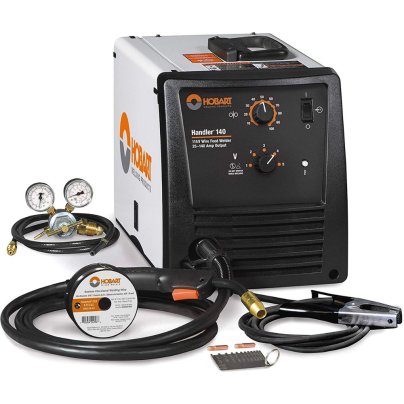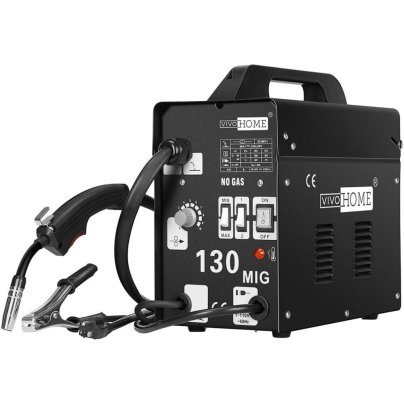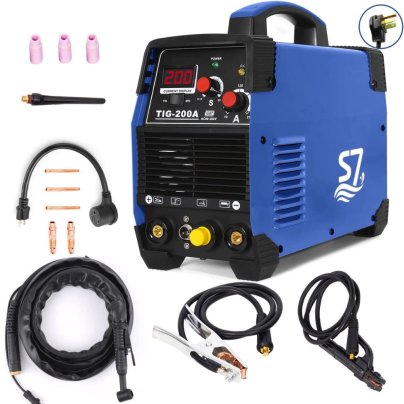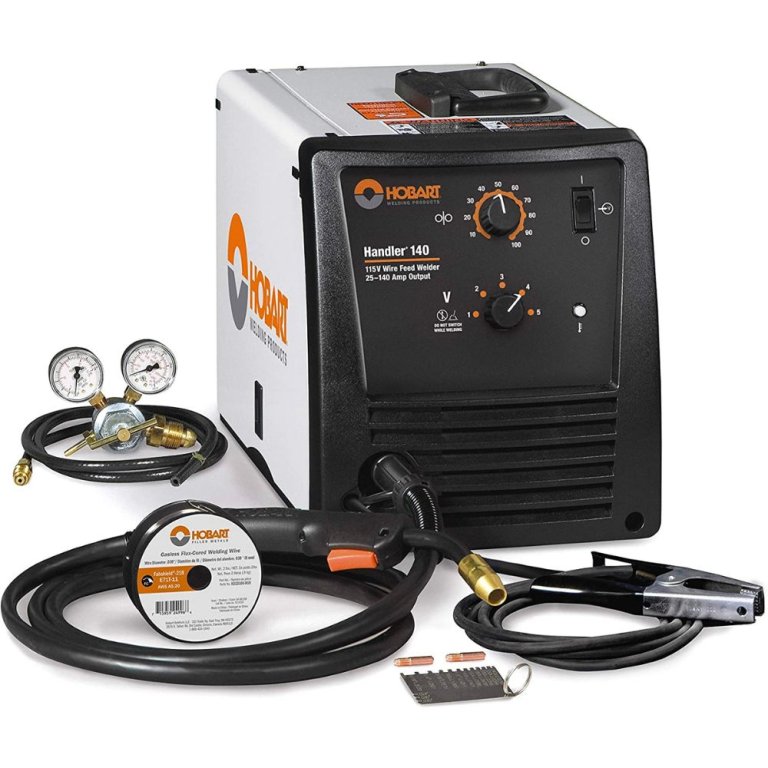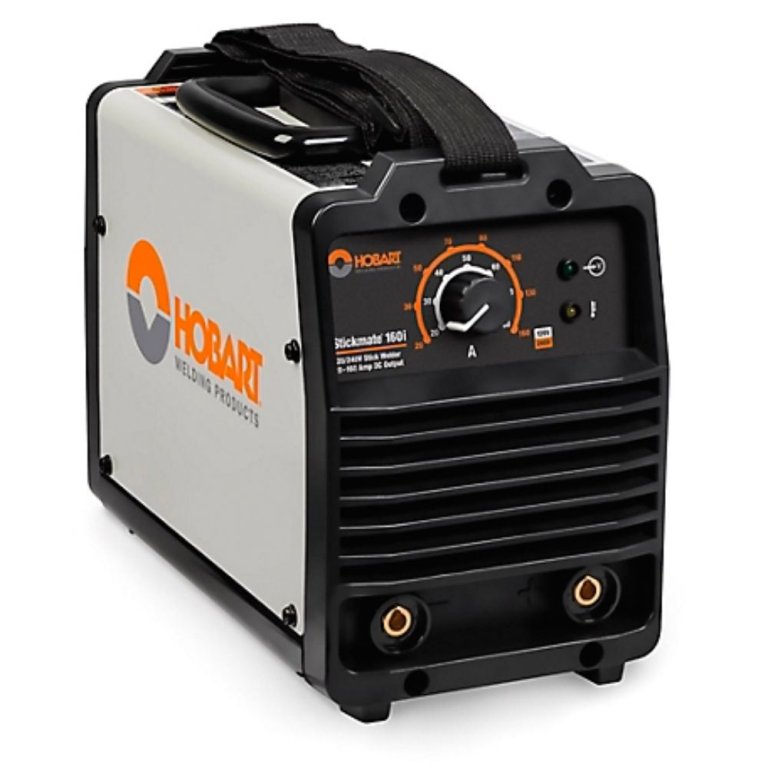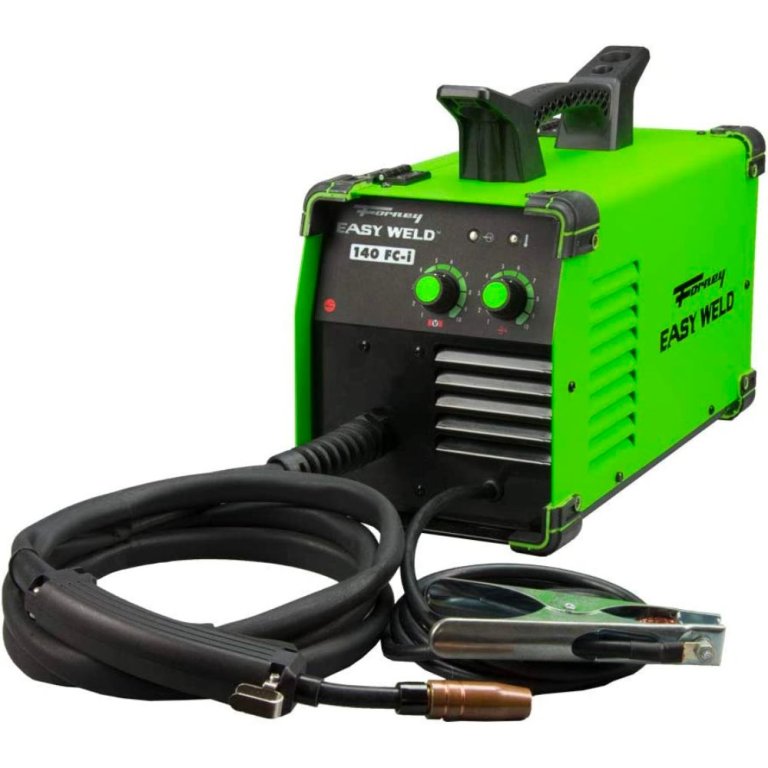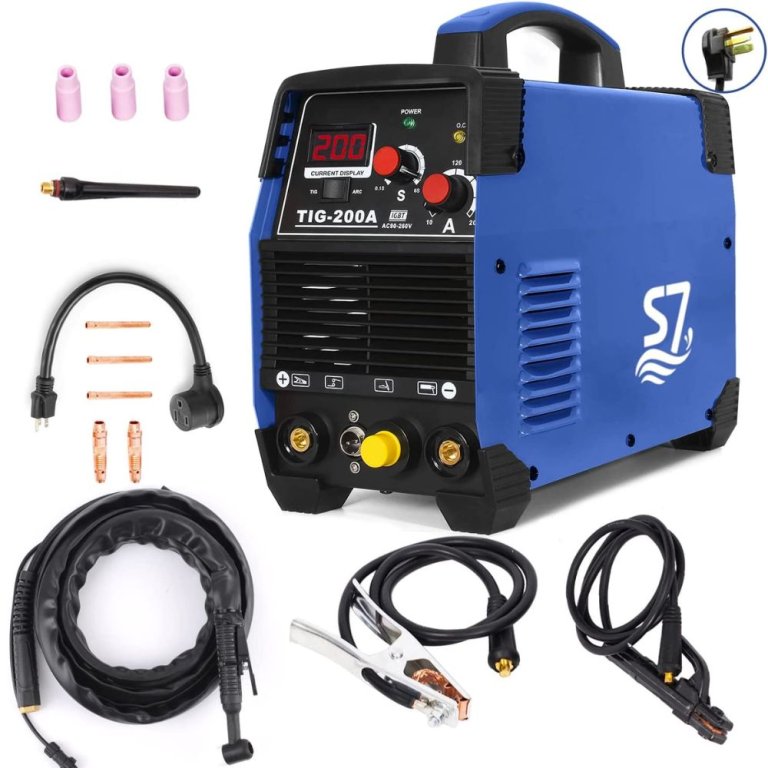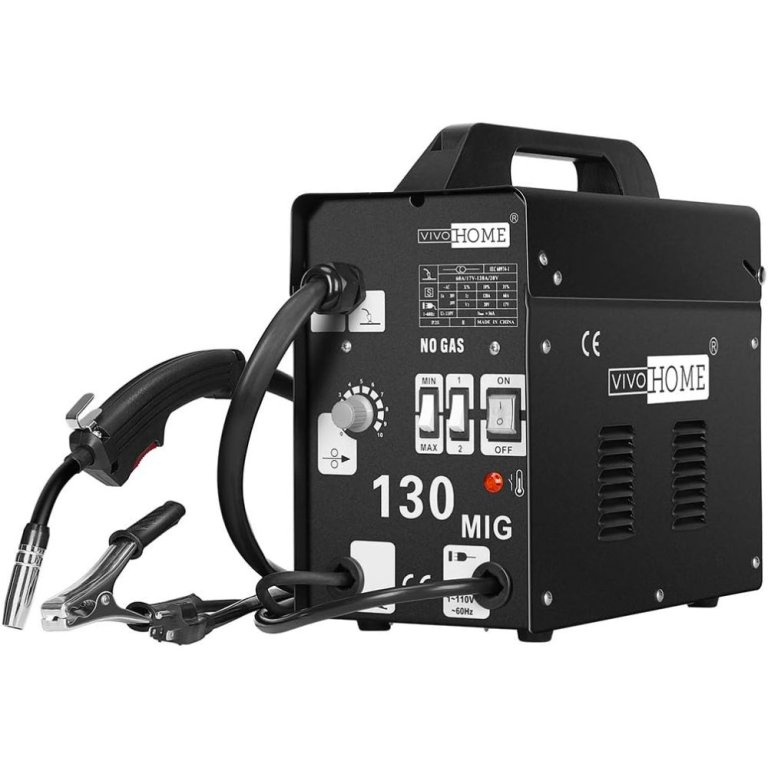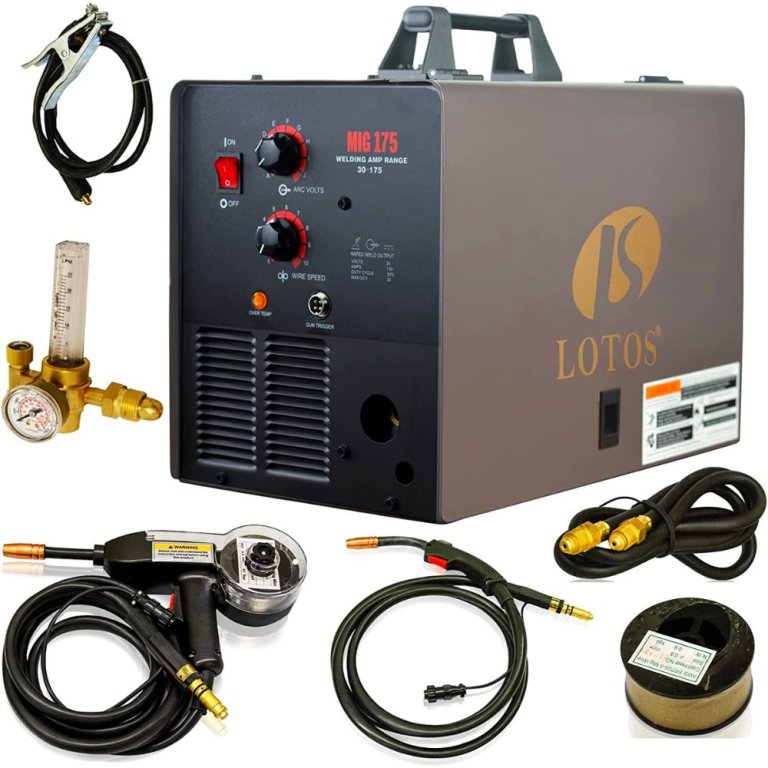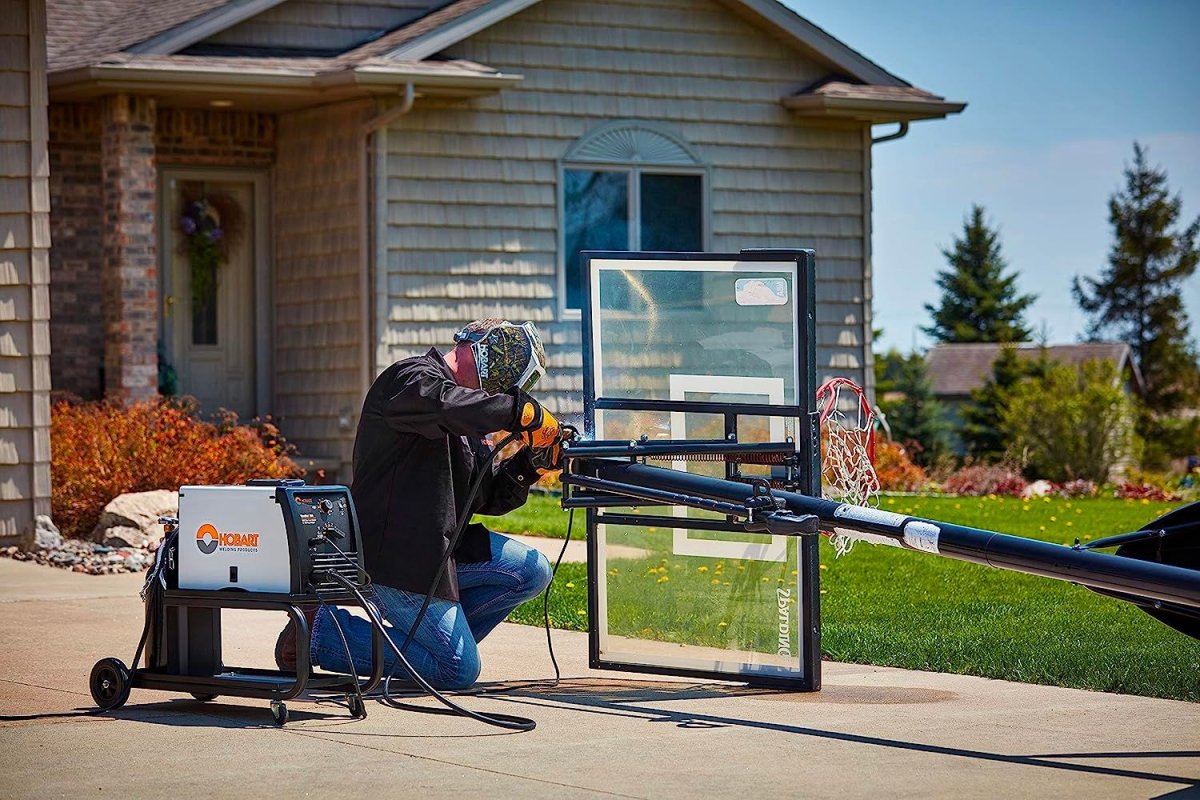
We may earn revenue from the products available on this page and participate in affiliate programs. Learn More ›
We tested several welders for beginners to find out which ones make learning to weld easier, safer, and less frustrating. After researching more than 20 welders, we selected seven for our lineup and tested the top four in our shops.
While all the welders you’ll find here are good picks for beginners, we found a favorite—the Hobart Handler 140 MIG Welder. The Hobart excelled in our hands-on tests, and it offers users the option of MIG or flux-core welding.
Getting started with welding isn’t especially difficult, but there are several welding processes to understand, and most machines are built for a specific type of welding. Even the most beginner-friendly welder won’t be the right tool for every task.
Without some background, it’s easy to choose the wrong equipment and waste money. Our guide offers practical advice, clear technical insights, and tested recommendations for choosing the best welder for beginners.
- BEST OVERALL: Hobart Handler 140 MIG Welder
- BEST BANG FOR THE BUCK: Harbor Freight Titanium Easy-Flux 125
- BEST FLUX CORE: Forney Easy Weld 140 FC-I Flux Core Wire Welder
- BEST MULTIPROCESS: YesWelder MIG-205DS-B Multi-Process Aluminum Welder
- BEST TIG: S7 200-Amp HF TIG/Stick/Arc TIG Welder
- BEST SIMPLE OPERATION: Vivohome MIG Welder 130 Flux Welding Machine
- ALSO CONSIDER: Lotos Technology MIG Welder MIG175 Wire Feed Welder
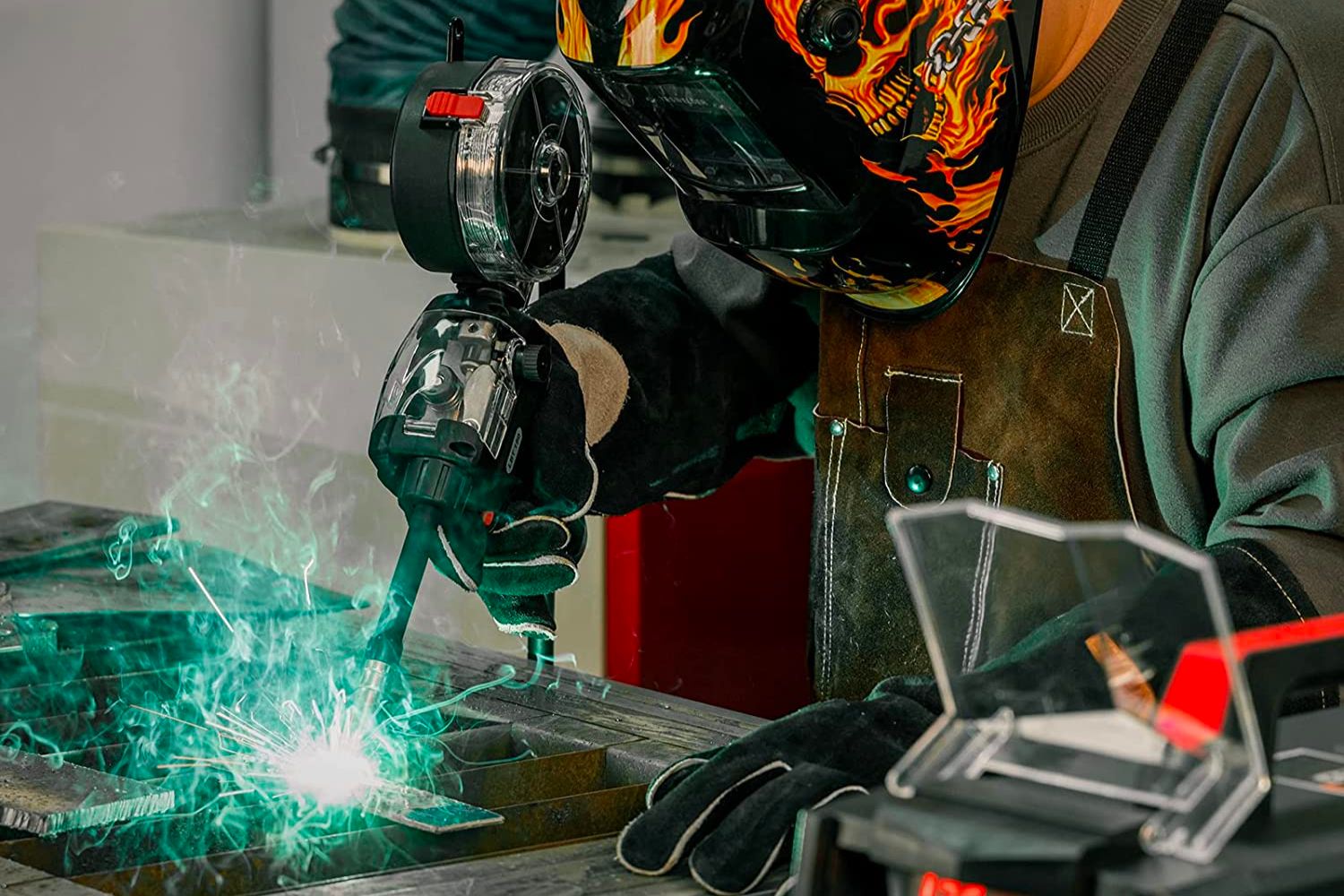
Welders for Beginners Comparison
| Product | Amps | Duty cycle | Weight |
| Hobart Handler 140 MIG Welder | 25 to 140 | 20 percent at 90 amps | 57 pounds |
| Harbor Freight Titanium Easy-Flux 125 | 30 to 125 | 30 percent at 90 amps | 15 pounds |
| Forney Easy Weld 140 FC-I Flux Core Wire Welder | Up to 140 | 30 percent at 90 amps | 19 pounds |
| YesWelder MIG-205DS-B Multi-Process Aluminum Welder | 30 to 205 | 60 percent at 200 amps | 23 pounds |
| S7 200-Amp HF TIG/Stick/Arc TIG Welder | 20 to 200 | 85 percent at 180 amps | 18 pounds |
| Vivohome MIG Welder 130 Flux Welding Machine | 50 to 120 | 15 percent at 105 amps | 34.6 pounds |
| Lotos Technology MIG Welder MIG175 Wire Feed Welder | 30 to 175 | 20 percent at 175 amps | 85 pounds |
Our Top Picks
We tested the first four welders on this list and then selected three more to round out our recommendations. You’ll find mostly MIG and flux-core welders, but we also included a couple of TIG welders. These options suit a range of budgets, and all are suitable for beginners.
Best Overall
Hobart Handler 140 MIG Welder
Pros
- Professional quality and reliability from one of the world’s leading welder brands
- MIG and flux core combo can weld steel, stainless, and aluminum indoors or out
- Easy to set up and use; runs from a standard household outlet
Cons
- Beginners may want to start with something a bit less expensive
Product Specs
- Amps: 25 to 140
- Duty cycle: 20 percent at 90 amps
- Weight: 57 pounds
Our Ratings
| Ease of Use | 4.8/5 | Performance | 4.5/5 | Portability | 5/5 | Value | 4.8/5 |
With so much variety available, selecting a single model as the best overall welder for beginners is challenging. But, in our tests, the Hobart Handler 140 MIG welder earned top honors in several assessments. It was the only model that came with wire, and we could choose between flux-core and gas MIG welding.
Plus, the Hobart comes from one of the industry’s leading brands. Not only was it easy to use, but it also has a quality build and the potential to deliver professional results. It consistently tops independent reviews as the best MIG welder for beginners.
It will weld a maximum of ¼ inch in mild steel, and it can also be used for stainless, cast iron, and aluminum. The wire feed speed range is impressive; we were able to start slowly but speed up as we got the hang of the machine.
The 20 percent duty cycle (meaning you can weld for 2 minutes out of every 10) is shorter than some other models, though learners may welcome the breaks. While the Hobart Handler 140 is a significant investment, it offers excellent durability, and with its competitive performance, it might be the only welder you’ll ever need as you grow your skills.
What our tester says: “I like knowing that the Hobart Handler gives me room to grow. I can practice on it as a beginner and keep using it confidently as I take on more advanced projects.”—Glenda Taylor, Product Reviews writer and tester
Get the Hobart Handler welder for beginners at Amazon, Tractor Supply Co., or Northern Tool + Equipment.
Best Stick
Hobart 500570 Stickmate 160i
Pros
- Powerful, robust machine designed for heavy-duty welding, particularly outdoors
- Dual voltage capability with precise control in single-amp increments
- Very lightweight and includes an adjustable shoulder strap for easy portability
Cons
- It’s quite a lot for the beginner to invest in a single-process welder
Product Specs
- Amps: 20 to 160
- Duty cycle: 30 percent at 160 amps
- Weight: 15 pounds
Our Ratings
| Ease of Use | 4.2/5 | Performance | 4/5 | Portability | 5/5 | Value | 5/5 |
Harbor Freight’s Titanium Easy-Flux Welder offers surprisingly good performance at an affordable price point. We were pleasantly surprised to find we could make adequate welds on steel up to 3/16-inches thick. This is a MIG-style welder in the sense that it uses a wire-feed process, but instead of an external gas tank, the flux-core wire generates its own shielding gas as it burns.
The Titanium was easy to set up, and it weighs just 15 pounds, making it light enough to carry to different locations. It has user-friendly dials—one for wire speed and the other for voltage—so it’s less intimidating than some models.
The only downside we noticed was that the welds were a bit on the sloppy side—there were more splatters and smoke. For that reason, we’d suggest using the Titanium in an outdoor location.
Still, this is a nice little starter welder for developing skills and welding smaller projects. It did the best job on ⅛-inch steel, and for the price, it’s hard to beat.
What our tester says: “Even as a budget pick, the Forney Easy Weld delivers consistent performance on ⅛-inch steel, and it’s intuitive to use—just a great entry-level tool.”—Glenda Taylor, Product Reviews writer and tester
Get the Harbor Freight Titanium welder for beginners at Harbor Freight.
Best Flux Core
Forney Easy Weld 140 FC-I Flux Core Wire Welder
Pros
- A reliable, high-quality flux core welder priced to be affordable for beginners
- Easy to use for the hobbyist but with performance that appeals to pros
- Tough all-metal construction, yet lightweight and easy to carry around
Cons
- Wire feed speed is a little slow, which some may find frustrating as their skill improves
Product Specs
- Amps: Up to 140
- Duty cycle: 30 percent at 90 amps
- Weight: 19 pounds
Our Ratings
| Ease of Use | 4.3/5 | Performance | 4.3/5 | Portability | 5/5 | Value | 4.7/5 |
The Forney Easy Weld is another good flux core welder for beginners who want to invest in quality and durability from the start. We found it to be a well-made machine that offers both performance and portability.
This wire-feed welder plugs into a standard 110-volt outlet, and the setup simply amounts to choosing voltage from the variable dial and setting feed speed, and it’s ready to weld. While the speed has 10 settings, none are particularly fast. This is ideal for those learning to weld, but it can be a little frustrating for pros.
The Forney Easy Weld can weld steel up to ¼ inch thick, but we found it most effective for ⅛-inch thick steel. Like all flux core welders, it cannot weld aluminum. With a little practice, we were able to run a clean bead with a minimum of spatter. This is an upgrade from our budget pick that’s still reasonably priced for those just learning how to weld.
Get the Forney welder for beginners at Amazon, The Home Depot, or Tractor Supply Co.
Best Multi-Process
YesWelder MIG-205DS-B Multi-Process Aluminum Welder
Pros
- Tremendously versatile welding machine that can be used for MIG, TIG, and stick welding
- High performance with an impressive duty cycle, plus dual voltage capability
- Easy to select desired process and can weld steel, stainless steel, and aluminum
Cons
- Although it is capable of TIG welding, the required torch will cost extra
Product Specs
- Amps: 30 to 205 (depending on process)
- Duty cycle: 60 percent at 200 amps (at 220 volts)
- Weight: 23 pounds
Our Ratings
| Ease of Use | 4.3/5 | Performance | 4.5/5 | Portability | 4/5 | Value | 4.7/5 |
The YesWelder MIG-205DS-B can weld using MIG, TIG, or stick processes. This might seem intimidating for a beginner, but we found it surprisingly user-friendly. The required process is selected from a single button, and many setup functions are semi-automated.
The YesWelder MIG-205DS-B will run off 110-volt or 220-volt supplies, making it a go-anywhere machine that can take full advantage of the flexibility offered by multiprocess capability. It has a longer duty cycle than many similar welders, and it can weld up to 3/8-inch-thick steel.
The price is competitive, and this YesWelder model has proven reliability. The only real drawback is that while it is TIG capable, the required TIG torch is not included in the sale, so we could not test that feature.
Overall, this is a good choice for serious beginners who want to learn more than just MIG or flux-core welding. Its LED display makes it easy to see live readouts at a glance, and it has mode-specific settings so users can get good results without having advanced welding knowledge.
Get the YesWelder welder for beginners at Amazon.
More Great Options
We didn’t personally test the following welders, but they made our shortlist due to customer satisfaction, reported build quality, and ease of use. If you’re still shopping for the best welding machine for beginners, check these out.
Best TIG
S7 200-Amp HF TIG/Stick/Arc TIG Welder
Pros
- A very affordable TIG welding machine for beginners that also offers stick welding
- Lightweight for easy portability; can run from both 110-volt and 220-volt supplies
- Offers numerous safety and energy-saving features, and includes all necessary accessories
Cons
- Only intended for light-duty welding, and quality control can be inconsistent
Product Specs
- Amps: 20 to 200
- Duty cycle: 85 percent at 180 amps
- Weight: 18 pounds
Beginners eager to try TIG welding will probably want to do so with minimum outlay, and the S7 TIG/stick/arc welder is very affordable. We like that it runs off a standard household supply or from a generator for those who want to use the stick process outdoors. It is lightweight at just under 18 pounds and very easy to carry around.
At 85 percent, the duty cycle is the highest we have seen on any welder for beginners. Part of that is due to relatively low heat generation, and the maximum thickness in steel is 3/16 of an inch. The S7 will weld stainless steel but not aluminum.
Considering the low price, there might be some concerns over durability—yet this is a very popular entry-level TIG welder, and feedback is largely positive. Unfortunately, the instructions provided aren’t very clear, and in general we recommend that anyone hoping to start TIG welding gets help from a pro or takes a local class to learn the basics.
Get the S7 welder for beginners at Amazon.
Best Bang for the Buck
Vivohome MIG Welder 130 Flux Welding Machine
Pros
- A high value-for-money package that provides everything the beginner needs to start welding
- The simple process and straightforward controls make it easy to operate while learning
- Plugs into a standard 110-volt outlet, making it convenient for welding at home
Cons
- Buyers will want to upgrade from the supplied mask, which is only handheld
Product Specs
- Amps: 50 to 120
- Duty cycle: 15 percent at 105 amps
- Weight: 34.6 pounds
The Vivohome is a budget-friendly flux core welder with the inherent simplicity that the process offers. We like that it includes everything the beginner needs to start welding, including welding wire. It plugs into a standard outlet and can weld mild steel and stainless steel, but not aluminum.
Controls are basic: there are four voltage settings, and while the wire feed has 10 positions, speed is a question of trial and error. While that might be frustrating for advanced welders, it offers a simple way for beginners to adjust the dial to a speed that suits their skill level.
A weight of slightly over 34 pounds offers reasonable portability. However, with a minimum 50-amp output, this isn’t a tool for delicate welding. Also, somewhat confusingly, although “130” is in the name, the maximum output is 120 amps. In real performance terms, it doesn’t compete with high-quality MIG welders like the Hobart Handler that earned the top spot on our lineup, but it is a practical machine for those who want to learn how to do welding.
Get the Vivohome welder for beginners at Amazon or Walmart.
Also Consider
Lotos Technology MIG Welder MIG175 Wire Feed Welder
Pros
- Exceptional quality and durability from one of the industry’s top brands
- Focused on welding aluminum but equally capable with mild steel and stainless steel
- Full kit of accessories including basic mask, chipping hammer, wire brush, regulator, and wire
Cons
- Not suited for home use since heavy 220-volt power supply is required
- The kit’s included handheld mask is of poor quality
Product Specs
- Amps: 30 to 175
- Duty cycle: 20 percent at 175 amps
- Weight: 85 pounds
Lotos Technology, another top welding machine manufacturer, designed its MIG175 for light-to-medium-duty professional work, but its ease of use makes it suitable for beginners. This true MIG welder uses gas but also allows for flux-core welding. We like that it comes with everything needed to get started, including a gas regulator, a basic mask, a chipping hammer, a wire brush, and a spool gun specifically for welding aluminum. Maximum weld thicknesses are ¼ inch in mild steel and 3/16 inch in aluminum.
At 85 pounds, it is surprisingly heavy compared to similar tools, but MIG can’t be used outdoors, so reduced portability is unlikely to be a problem. This model is best-suited for someone with a designated shop.
The Lotos MIG175 requires a 220-volt supply, which prevents us from recommending it as the best welder for home use. Many homes are not wired with a 220V outlet, so a generator or a dedicated socket would need to be installed. We like the digital display, and customers indicate it delivers good arc stability and clean welds.
Get the Lotos Technology welder at Amazon or The Home Depot.
Jump to Our Top Picks
How We Chose and Tested the Best Welders for Beginners
| Products tested | 4 |
| Time spent testing | 2 weeks |
| Tests performed | 4 |
| Price range | $150 to $700 |
While welding isn’t difficult, it can be confusing for someone who’s never tried it before. In curating our list for this lineup, we primarily looked for MIG welders (see welding term definitions below) that were flux-core compatible, meaning they weld without needing a gas tank. We looked for simple controls and presets to make setup easy for beginners, and we also wanted models that plugged into a standard 120V outlet. Then, to cover all bases, we added a MIG welder that supports both gas and flux-core wire.
In our hands-on tests, we analyzed each welder’s build quality and assessed the setup process and how clear the instructions were. Once set up, we performed simple welds on basic steel using the recommended settings. We focused on how easy it was to start the weld, maintain a steady arc, and lay down a smooth bead. Overall, we performed about three dozen test welds using each welder.
We awarded points based on a rubric, and after testing was over, we averaged the numbers to determine our best overall pick and to categorize the other machines for their best use.
| Product | Ease of Use | Performance | Portability | Value |
| Hobart Handler 140 MIG Welder | 4.8 | 4.5 | 5 | 4.8 |
| Harbor Freight Titanium Easy-Flux 125 | 4.25 | 4 | 5 | 5 |
| Forney Easy Weld 140 FC-I Flux Core Wire Welder | 4.3 | 4.3 | 5 | 4.7 |
| YesWelder MIG-205DS-B Multi-Process Aluminum Welder | 4.3 | 4.5 | 4 | 4.7 |
What to Consider When Choosing a Welder for Beginners
To help beginning welders understand this valuable skill, this guide will explain each of the four main welding processes—namely, how they work and what each is capable of achieving. We’ll then move on to the various features that define how the machine performs and how practical it is for a particular range of tasks.
Type of Welding Process
Let’s start by clearing up a common point of confusion. People often use the term “arc welding” as if it is a specific process. It’s not unusual, for example, to see questions such as, “Is arc welding better than MIG welding?” In actuality, all the welding processes described here fall under the broad category of “arc welding.” They all create an arc of electrical current between the tool and the metal to be welded. This arc provides tremendous heat, melts the metal, and forms a weld. The following explains how each arc welding process differs and the typical uses for each. What’s not covered here is plastic welding, which is a different process entirely.
MIG
MIG stands for “metal inert gas.” It is also called gas metal arc welding (GMAW). It is generally regarded as the easiest form of welding for beginners to learn. The machines that perform MIG are usually simple to set up, and the process is quite forgiving. A welding wire feeds automatically through a handheld welding gun. The welding wire and the metal melt together to form a weld. Wire speed can be varied to suit the metal being joined and the skill of the welder.
During any welding process, the molten metal could be contaminated by dust, dirt, or chemicals in the air. This can cause weaknesses in the weld. To avoid contamination, a protective shield is formed. MIG welding achieves this using gas (usually a mix of argon and carbon dioxide) from a separate bottle. Because the shield is easily disrupted, MIG welding is done indoors to reduce the chance of contamination.
MIG is great for welding mild steel, and it’s good with stainless steel or cast iron as well. Some machines can also weld aluminum. With practice, it can make fairly neat welds, though some cleanup may be required if the weld is going to be visible.
Flux Core
Strictly speaking, flux core arc welding (FCAW) is a type of MIG process. The term “gasless MIG” is often used. The equipment is very similar, and in fact, many MIG welders offer both MIG and flux core capability.
The big difference is that flux core welding doesn’t need a separate gas supply. Instead, the gas shield is formed by chemicals contained within the welding wire. These are released as the wire melts. The shield is less easily disturbed, so flux core can be used outside. Without the need for gas bottles, flux core welding is also more portable than standard MIG welding.
The drawbacks are increased spatter (droplets of molten metal that get spat off) and less tidy welds. When done correctly, flux core arc welds are as strong as gas metal arc welding, but they may require grinding afterward. Flux core welding is good for steels and cast iron, but it cannot weld aluminum because aluminum wire is not available with flux included.
TIG
Tungsten inert gas is also known as gas tungsten arc welding (GTAW). The main difference between MIG and TIG is that the latter creates an arc using a nonconsumable electrode that melts the two metals while a filler rod is fed in manually. This requires two hands and may also involve a foot control to adjust power.
The result is a complicated process that takes time to master, so TIG welding is not generally recommended for absolute beginners. When compared to MIG, it is also quite slow.
The upsides are that TIG welds can be very strong and very neat. Professional welders usually choose TIG when precision is required because they have greater control. It can also weld just about any metal and is the preferred option for titanium and magnesium.
Stick
Stick welding is also called shielded metal arc welding (SMAW). It uses the same basic principle as flux core welding, except the chemicals required to create the shield are contained within a solid stick. The stick is held in a clamp, rather than a gun, so it takes a little while to get accustomed to the technique.
Stick welding is usually used on steel, but it can work with a variety of metals. The big advantage is that the shield is strong and very stable, so stick welding can be used outdoors in almost all conditions. In fact, one type of stick welding can be done underwater.
Stick welding offers excellent penetration and great strength, and it can weld substantial thicknesses. However, it is messy. It can create a lot of spatter, and as the stick burns, it leaves a layer of slag (shield waste). It looks untidy, so it often needs to be chipped away with a hammer or ground off with an angle grinder, which means extra work.
Duty Cycle
Overheating is a potential problem with all welding equipment. To prevent this from happening, each machine requires rest periods. The length of time the welder can run before a welding machine needs to rest is called the “duty cycle.” It is usually given as a percentage of 10 minutes. For example, a duty cycle of 40 percent means that after 4 minutes of welding, the machine needs a 6-minute break.
Even the best welder for beginners can’t run without a break. Some duty cycles are as low as 20 percent; shorter duty cycles are often associated with powerful welders simply because they generate more heat, but there are no hard and fast rules, so each model needs to be considered separately.
For many people who are learning to weld, a modest duty cycle will not be a problem. Concentrating on the process for more than a few minutes is quite tiring at first. However, as skills improve, short duty cycles can become frustrating.
Power and Metal Thickness
Most welders for beginners can run off a standard 110-volt household supply. Some of the more powerful models are dual voltage and can also run off a 220-volt supply. The latter comes from either a dedicated outlet or a generator.
The amperage, or amps, rating is an indication of the thickness of metal the machine is capable of welding. Higher amps generate more heat. However, two machines of the same amperage might have different maximums, so each welder needs to be looked at individually.
Minimum amps are often overlooked, but this is another important figure because it helps to define the thinnest metal a machine can weld. Sometimes, a machine can’t be turned down low enough for thin sheets. Excess heat will melt the metal too quickly so the weld can’t form.
Portability
Many beginners will learn to weld at home or in an organized class, so the portability of the welding equipment may not be a significant issue. However, even moving gear around a garage or a small workshop can be awkward if the machine is heavy. With both MIG and TIG, there is a gas bottle to consider (they weigh around 28 pounds when full). Carts are available to mount everything on, but there can still be significant weight to move around.
As already noted, flux core and stick welding are the two welding processes most likely to be used outdoors, so in these cases, portability is more likely to be important. Fortunately, neither of these requires gas, so it’s only the weight of the machine itself that needs to be considered.
Additional Features
- As mentioned above, MIG welders often offer flux core as well. There are other multiprocess welder types, too. It’s not unusual to find MIG/TIG welders or even MIG/TIG/stick combinations. These give the beginner the opportunity to try different welding techniques, though they are often more expensive than single-process models.
- A welding mask is an absolute necessity, and some of the best welders for beginners include one in the kit. However, these are generally handheld, and while adequate from a safety perspective, a proper welding helmet not only offers better protection but also keeps both hands free.
- Gas bottles need a regulator to control flow. Often these are included with MIG or TIG equipment, but they may need to be purchased separately.
- A chipping hammer (for removing slag) and a wire brush are useful extras.
FAQs
The guide above provides a wealth of information to help beginner welders choose the right equipment, and it will most likely have answered many questions that may arise. However, during our research, we noted some general queries that might benefit from further explanation. These are dealt with below.
Most experts agree that the easiest type of welding for beginners to learn is MIG, and the easiest type of metal to weld using this process is mild steel. However, as explained above, it is very difficult to MIG weld outdoors. A flux core welder for beginners is a good alternative, and MIG/flux core combos are fairly common. For those who expect to weld a variety of materials, both indoors and out, a multiprocess welder like the YesWelder described above is also worth considering.
Although there is always a small risk of getting an electric shock from a welder, it is not likely if the proper safety precautions are followed. Ground clamps, which are necessary to create the welding arc, reduce the hazard in part, though they are not foolproof. Some welding machines have a safety feature called a “cold start,” where current doesn’t flow until the trigger is pulled; this reduces the risk even further.
Burns from hot metal (spatter) are probably a more significant danger, so it’s vital to wear a welding helmet, a protective welding jacket, and proper welding gloves.
It’s difficult to provide a precise answer here because, to some extent, it depends on the metal being welded. TIG provides good penetration and weld consistency, so it’s arguably the strongest in terms of pure weld structure, though for beginners it is easier to produce a strong weld with MIG. That said, stick welding would be the stronger choice for metal that is dirty or rusty, and for welding outdoors. In truth, any welding process done properly produces joins of excellent strength.
There are numerous factors that determine the best size welder for you, and the capabilities of various welders for beginners are detailed in the article above. A lot depends on the thickness and the type of metal you will weld most often. Many home welding machines work on fairly thin material, so a big, powerful welder isn’t entirely necessary. The degree of portability required is another consideration. However, for those who intend to weld regularly, it is perhaps worth investing in a larger, more capable machine rather than buying a cheap welder that eventually requires getting an upgraded model.
Arc welding is a general term covering all four processes discussed above. MIG welding is not separate from arc welding, but is one of the arc welding processes. Weld strength depends on both the type of process and the kind of material being welded. For example, stick welding is often considered stronger than MIG when welding very thick metal, but it could easily burn through thin metal; in that case, MIG would be the stronger choice. TIG welding also produces strong welds in thinner metals, but it requires more skill. For many, particularly beginners, MIG welding equipment is a good choice.
It depends on the model. Many of the best welders for beginners in this lineup only require a 110-volt supply, so they can be plugged into a regular outlet. Some welders can run off either a 110-volt or a 220-volt supply. They can be switched from one to the other. This can be convenient for those who weld both at home (where regular outlets are common) and in commercial situations where a 220-volt supply is available. Using 220 volts often results in higher performance. Professional welders, such as those used in factories, engineering shops, etc., will often only run from a 220-volt supply.
